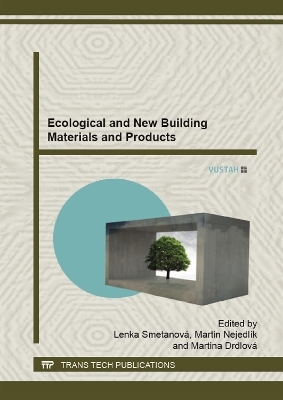
Ecological and New Building Materials and Products
Trans Tech Publications Ltd (Verlag)
978-3-03835-587-8 (ISBN)
- Titel nicht im Sortiment
- Artikel merken
Collection of selected, peer reviewed papers from the 19. Conference of Research Institute for Building Materials Ecology and New Building Materials and Products, June 2-4, 2015, Černá Hora, Czech Republic.
The 49 papers are grouped as follows:
Chapter 1: Binders;
Chapter 2: Composite Materials;
Chapter 3: Building Materials Based on Secondary Raw Materials;
Chapter 4: Technology and Testing Methods
Preface and Committees
Chapter 1: Binders
Mechanism of Immobilization of Toxic Elements in Special Binders
Dispersants for Dual Binding System Kaolin - Calcium Aluminate Cement
Diffusion Parameters of Basic Diffusion Adhesive Mortars with Silicate or Acrylic Plaster
Hydration of Synthetized Clinker Phases C3S and C3A with Metakaolin in Isothermal Conditions
Substitution of Limestone in Raw Mixture for Burning Portland Cement by FBC Ash
Influence of Chemical Admixtures on Properties of Alkali-Activated Slag-Based Mortars
Chapter 2: Composite Materials
Production of Self Compacting Concrete SCC with Portland and Blended Cement CEM I, CEM II with Fly Ash and Limestone Admixtures
Evaluation of Mechanical Properties of Glass/Epoxy Syntactic Foams Containing Carbon Nanotubes and Nanosilica
Mechanical Fracture Properties of Cement Mortars with Diatomite in Relation to their Microstructure
Hygrothermal Behaviour of Newly Developed Thermal Insulation Plasters with Natural Fibres
Cementitious Composites in Severe Environmental Conditions - Dynamic Loading
Study of Surface Treatment of Freshly Fabricated Concrete Roof Tiles
Experimental Tests of White UHPC Plates Reinforced by PVA Fibres and Textile Glass Reinforcement
Fibre Reinforced Polymer Rebar
Study of Hygrothermal Behavior of Insulation Materials Based on Natural Fibers
Ballistic Performance of Al2O3 and SSiC Ceramic with Areal Density of 26 kg/m2 against 7.62 mm Calibre Projectiles
Possibilities of Using Natural Fibres for Production of Particular Insulation for Use in Civil Engineering
Research of Behaviour of Inorganic Matrix Composites Exposed to Extreme Temperatures
Development of Fibre-Cement Composites with Self-Cleaning and de-NOx Ability
Hempcrete - Cement Composite with Natural Fibres
Chapter 3: Building Materials Based on Secondary Raw Materials
Freeze-Thaw Resistance with Sodium Chloride Solution of Fly-Ash Concrete Mixtures
Effect of Polymer Admixtures on Mechanical Properties of Alkali-Activated Slag Mortars
Influence of Grinding Processes on Gypsum Microstructure
Effect of Different Cooling Conditions on the Properties of Composite Materials with Cement Based Matrix
Influence of Binder and Filler Modification of Composite Materials for Extreme Conditions on Development in Time Parameters
Influence of the Fly Ash Character on Quality of Artificial Aggregate
Sintered Artificial Aggregate with New Correction Raw Materials
Possibilities of Development of Thermal Insulating Materials Based on Waste Textile Fibers
Chapter 4: Technology and Testing Methods
The Use of Simulation Models for Complex Description of Permittivity of Building Materials
Changes of Electrical Parameters of Cement Chipboards Cetris-Basic after Freezing Cycle
Nondestructive Testing of Moist Cetris-Basic Wood-Cement Chipboards by Using Impedance Spectroscopy
Stress Distribution in Joints in Panel Structures
Influence of Superplasticizer Quantity on Formation of Micro-Cracks during Setting and Hardening of Concretes by Acoustic Emission Method
Determination of the Influence of Carbonation of Concrete and Corrosion of Steel on Reinforced Concrete Condition
Correlation between Parameters of Acoustic Emission and Fracture Characteristics Obtained from Three-Point Bending Test
Influence of Aeration of Concrete on Acoustic Emission and Fracture Mechanical Parameters Obtained from Three-Point Bending Tests
A Methodology for Evaluation of Shockwave Absorption by Blast Energy-Absorption Materials
Multichannel Laboratory Device for Measurement of Smart Concrete Material Properties
Possibilities of Aerated Concrete Remediation through the Usage of Injection Screens
Application Possibilities of Hydrophobised Ceramic Walling in Areas with Higher Risk of Floods
The Application of NUS Method for Concrete-Covered Steel Corrosion Monitoring
Influence of Water Content on Fundamental Frequency of Mortar Sample
Correct Choice of Maximum Length Sequence in Nondestructive Testing
Permeability Measurement of High Performance Concrete at Elevated Temperature Employing a New Test Set-Up
Comparison of Modal Analysis Using FEM and Eigenfrequency Measurements
Impact-Echo Method for Non-Destructive Testing of High-Temperature-Degraded Cement-Based Composite
Experimental Verification of Properties of Roller-Compacted Concrete for Pavements
One-Year Sulfate Attack on Various Types of Fine Grained Concrete
Comparison of Bond Behaviour between Reinforcement and UHPC and Ordinary Concrete in Extreme Conditions
| Erscheinungsdatum | 07.11.2015 |
|---|---|
| Reihe/Serie | Advanced Materials Research |
| Zusatzinfo | Illustrations, unspecified |
| Verlagsort | Zurich |
| Sprache | englisch |
| Maße | 170 x 240 mm |
| Gewicht | 700 g |
| Themenwelt | Naturwissenschaften ► Biologie ► Ökologie / Naturschutz |
| Technik ► Bauwesen | |
| Technik ► Maschinenbau | |
| ISBN-10 | 3-03835-587-9 / 3038355879 |
| ISBN-13 | 978-3-03835-587-8 / 9783038355878 |
| Zustand | Neuware |
| Haben Sie eine Frage zum Produkt? |
aus dem Bereich


